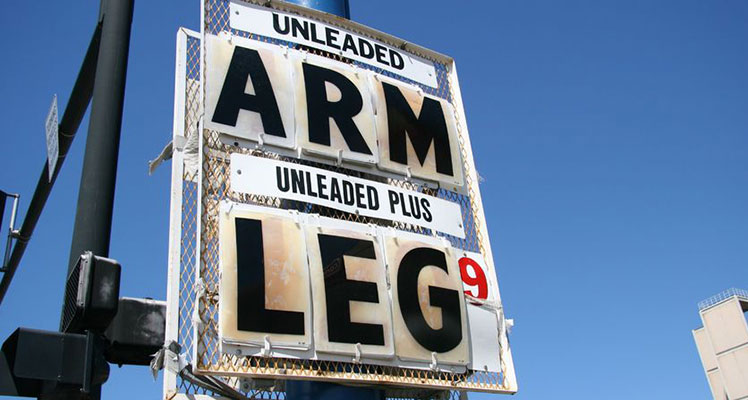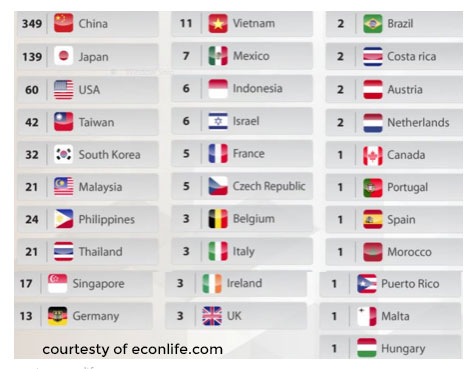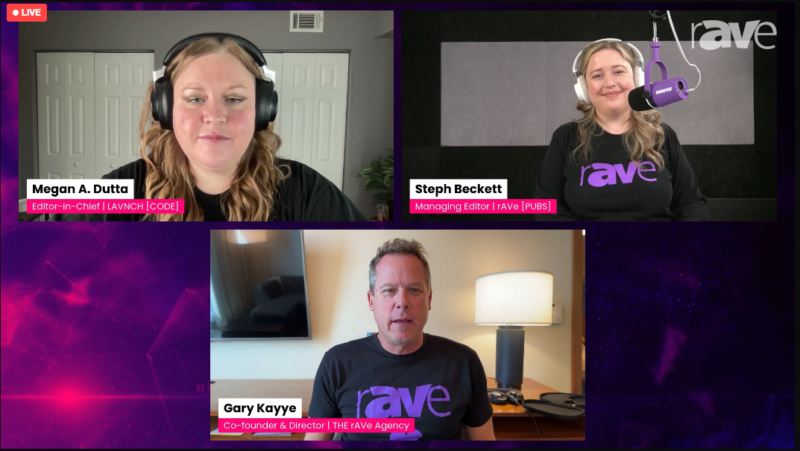The Real Cost of a Product
 Any one in the AV industry who specifies, purchases, sells or buys the essentials we use every day to build our systems knows that these “products” have a host of internal costs built into the price we pay. Let me be very clear, the price I am talking about is the net cost of the product to us, not the end-user or system price of that same product which would include our margins and other related additional costs.
Any one in the AV industry who specifies, purchases, sells or buys the essentials we use every day to build our systems knows that these “products” have a host of internal costs built into the price we pay. Let me be very clear, the price I am talking about is the net cost of the product to us, not the end-user or system price of that same product which would include our margins and other related additional costs.
The core price (which is what one of the items would cost to keep the comparisons valid) is that price which we pay for any product, hardware, software, accessory or whatever as it arrives in our hands — the invoiced to us cost of the product.
Now of course there are variables in that final number such as how many of the items are bought (quantity discounts), dealer or re-seller incentives and so forth (but for the purposes of this discussion those are not considered). Whatever that final number may be, it will always include the obvious expenses associated with producing the product, such as R&D expenses, the cost of materials, the cost of custom fabricated molds for plastics or similar materials and so forth but it will also include some significant costs that are not so obvious, but do affect the price we pay for anything.
The Marketing Costs of Surprises
The first and most obvious add-on cost is marketing expenses. Now while you may think that means advertising, promotion, and similar standard type overhead, you may not realize that lumped into that cost center are trade show expenses, associated costs for factory and training personnel travel, events or meetings/seminars, those big-bash show parties and the hidden costs of some of those events.
For example, let’s look at what it really costs the average pro-audio industry non-mega company to attend a trade show.
- Booth space cost
- Setup/teardown of the booth
- Travel costs for company personnel and endorsers, trainers, etc.
- Food and beverage, especially if they throw a party or reception
Those four items are fairly obvious and nobody objects to those expenses, but here’s where it gets sneaky.
All that hardware, booth materials and such have to be shipped from the company or booth builder to the show site and back — i.e., round trip freight — which let’s say for the average exhibitor is about $1 a pound. Pretty normal for bulk truck freight. But that only gets the stuff to the convention site loading dock and here’s where a big cost surprise that you are paying for happens. In the convention business, there are service companies that provide everything from the fork-lift truck to moving freight to the tables, chairs, pipe & drape, carpet and so forth. While the costs vary by location, in major convention locations, a few companies control that business, have long term contracts with the convention centers AND set their own rates. Exhibitors have no say in those rates, they just get a bill and there are no alternative choices — it’s a closed system.
Here’s where the wallet-stunning numbers come into play. Based on data from a mid-sized loudspeaker company’s 2016 trade show costs, the cost to move 6,000 pounds of crates from coast to coast for a show was about $6,000 — but the cost to move that same 6,000 pounds of stuff about 200 feet from the loading dock to the booth site
(called “drayage” in the trade show business) was nearly $12,000 — or about $60 per foot vs. $1 per mile round trip (6,000 miles cost to coast to coast). That 12K did nothing to make a better product or improve customer service, or train dealers or anything useful, it just went into the marketing cost budget as an expense.
Do that a few times a year and suddenly you have $40K to $60K worth of costs to allocate to the dealer price of the product and you, the buyer, got nothing except a hidden cost increase. The same kind of gigantic cost multiples apply to furniture rentals (again, no choice in who you have to rent from) or any similar expenses. Toss in some mandatory $90+ per-hour union electricians and $95+ per-hour union carpenters, $90+ per-hour miscellaneous union labor and wham — what the company faces is a bill that was three, four or five times the original cost estimate. In many of these venues, your own people (company that is) can’t even touch a screwdriver without paying for a union person match. So if you bring five people to set up your booth you have just bought five union people to go with them. Do the math. It get expensive very quickly. Trust me — you’re paying for those costs.
Licensed IP/Technology
Almost every product that wants to offer real IT/IP connectivity needs to provide connectors based on proprietary, licensed-use technologies such as DisplayPort, HDMI and other options as well. Designing the hardware or acquiring the IP/software for this is easy and straightforward. But then there are the licensing costs. For example, in a recent blog post, Gary Kayye commented on this issue: “I was talking to one of my oldest industry friends at ISE in Amsterdam and he told me how he’d been “shaken-down” by the MPEG LA (the licensing people for DisplayPort). Basically, some two years after he’d been selling products with DisplayPort connectors, he was called, out of the blue, by the MPEG LA and told he needed to pay 16 cents for each DisplayPort connector on a product. So, if he’d sold a 1×4 DisplayPort distribution amplifier, he needed to pay $0.80 per unit sold. Plus he’d need to go back and figure out how much he owed since he started in business — back-payment.
This whole process reminded me of the neighborhood protection shakedown scheme. But it’s totally legal and officially above board.”
Now realistically, there has to be a proper and valid process for this worldwide and both the HDMI, LLC and MPEG LA are true consortiums/alliances run independently from any one manufacturer. They exist to set standards and enforce them. Thus, these fees go to fund the association and support the licensed technology and its users. But, it does add to the cost of the product and you probably didn’t think about that. Sure it’s only pennies, but it adds up and if the product in question uses multiple licensed IP or technologies to provide what the market wants, it’s paying multiple organizations for every unit shipped, assuming the manufacturer is obeying the laws and rules.
So add a few bucks to each product for this low visibility cost. Yes, they are necessary but because the AV world allows closed source ‘standards’ to exist these costs remain. Perhaps it’s a reason to push for and look to open source options and new paths to get the result? Worth a calorie or two in thought.
Where It’s Made Matters – But
Ever read the fine print in those car ads — the part about being manufactured in the USA with GLOBALLY sourced parts? Well, where something is made does have an impact on its cost. Globally sourced really means exactly that for electronics. For reference, and to showcase that supply chain, the chart below shows the number of suppliers, by country, for an Apple iPhone. This chart includes EVERY company involved in putting that product on the store shelves.

(If you are really curious, go here for a detailed listing who makes what, where.)
Clearly, China (no surprise there) is the dominant player, not just because assembly costs (wages and overhead) at vendors like FoxConn are very low, but also because huge numbers of the component parts are also made in factories in China, especially plastics and various semiconductors. Please take note of the large numbers for Japan (semiconductors, optics) Taiwan, Korea (memory chips primarily) and then the southeast Asia semiconductor quartet of Malaysia, Thailand, Singapore and the Philippines. If this were a laptop, Malaysia would rise up to make a quintet because of its disc drive and semiconductor facilities. But even just listing the countries obscures the real data because a company nominally based in South Korea or Japan or Taiwan, for example, actually outsources to lower cost facilities, perhaps in Malaysia or Thailand or Vietnam. So the complex web is actually far more finely meshed than the data would indicate.
But despite this obvious globalization, the one topic that gets the most headlines and attention from spreadsheet MBA management types is the hourly wage paid to factory labor. Below is a table showing (as of 2015) the average hourly manufacturing wage (converted to U.S. dollars) for countries that produce electronics or components product used in or by the proAV industry worldwide. The website credited has much more data on this topic. But here’s the rub. The hourly wages to assemble and build a product is only a fraction of its total manufacturing cost — although it is the hot button pushed by every cost control addict in our industry. To truly reflect actual assembly costs, both direct material costs and direct labor costs must be included in the price calculations, which makes the hourly wage issue somewhat of a red-herring.

So if we take JUST the hourly wage (not a true number in and of itself) as representative of location-based manufacturing cost, building an amplifier in China saves $41 vs. Sweden and $14.02 vs. Korea. Based on only that number, it becomes obvious why companies think they will benefit by off-shore production.
But not calculated here are all the other costs associated with such off-shore production, like quality control, freight, inventory/stock overhead. If you have to wait eight weeks for the product to arrive you must have enough inventory in a U.S. warehouse to cover that eight weeks and that costs serious money, not to mention items such as inventory taxes, etc. (As an aside, ever wonder why a lot of companies moved warehousing to Nevada from California? California has an inventory tax; Nevada doesn’t.)
Now you know why almost every small kitchen or personal appliance says “made in China” on the box. It’s also why that really cool Italian-made Espresso machine at your local Starbucks costs thousands and the look-a-like you bought for your office from China cost $49.95 (we will not talk about the quality of the espresso).
But remember that “globally sourced” notation from earlier? Where these wage costs really matter is when a product is built in a high cost country for “cachet” or marketing purposes, but can and does source the labor intensive elements of that product from low cost countries. That is why it is possible to build amplifiers in Scandinavia and still be able to sell them for something way less than the national debt of a third world country — and remain competitive in a global market. It’s also why the boutique limited production ‘high-end’ audio stuff has a five-figure price tag — they can’t effectively source the tiny quantities of what they need from low cost suppliers because the numbers are too small to matter to the parts vendors. Nobody who is geared to make 10,000 of something a month (like power supplies for example) wants to sell a tiny boutique company 100 of them a year.
However, there are often no choices for some product categories — especially video displays, for example. When 90+ percent of the possible sources for an LCD/LED panel are located in China or nearby areas, the manufacturer, no matter where it is located, is left with no option but to source such panels from those suppliers. The same applies to almost every IC, memory chip, CPU, DSP, chip and so forth.
The Layer Cake Manufacturing Process
Where this can and does affect your cost is hidden in the layer cake of suppliers that have arisen in the supplier countries. Let’s assume you are XYZ Display Corp., and you supply commercial displays to a wide range of users. How much added no-value to the buyer/user cost is accumulated by any SKU you build will be determined by how well you manage and vet your OEM suppliers.
Think of this process as a layer cake. If the cake has four layers, it costs x dollars per slice. But if it has eight layers, it’s still the same cake but the per slice cost has nearly doubled — at a minimum. If the product gains no actual value from those four layers (other than pure size and calories), then the purchaser is paying more, but not getting more.
So, if XYZ just chooses the lowest cost OEM for the panel itself, but then has to find multiple other OEMs to supply the bezel, housing, power supply, connector panel, etc., — its bottom line landed cost will be higher than if they had done their due diligence and found an OEM that had those capabilities built into the supply chain from the outset.
The full-service OEM will almost automatically have lower overall costs because it’s sourcing all those other bits and pieces in huge quantities for many customers. But if XYZ sourced just the amounts they needed for their panels, directly, you can absolutely guarantee they are paying more for each part even if they are using exactly the same sub-vendors and suppliers. It’s a game of numbers and in this case, bigger means cheaper.
How do you determine how many layers are in the cake you are buying? It’s not all that easy, but you can compare products and look at the value equation and cost to get a idea of who’s doing their homework on the manufacturing side and who isn’t.
For example, if the company you’re buying from makes 15 panels sizes in multiple models vs. a company that has added five key sizes to their mix to provide “one-stop-shopping,” it’s more than likely that the second company is paying more per panel (and may well be relabeling the product from the larger panel vendor just to have the SKU), so your received value is likely to be lower if the prices are the same. The cost cutting is happening somewhere along the way — you can be sure of that.
In the End
What really matters on the bottom line is the amount of non-value cost added to any product.
How do you determine who’s giving you the most actual product value for the price? It requires a little thought, some research and, most importantly, evaluating the position of the product in the supplying company’s revenue mix.
What that means is not complicated. If you’re buying a product that is part of a company’s core mix of offerings, it’s more likely to have a higher net value than if you’re buying a low volume add-on or “just because product” from that same company. It’s highly probable that the supplying company is outsourcing that low volume, but we-think-we-need-to-offer-it product, since building only a few of anything costs way more than building thousands. Think about what you’re buying and from whom.
It may require you to rethink some vendor relationships, and look more closely at the supply-chains of the people you’re doing business with, but if you do, and do so thoughtfully, you may well find a better value equation at the end of the process.
Happy globalization!




